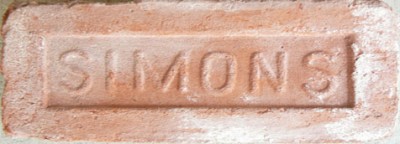Trademark ‘S’ is reminder of Simons brick manufacturer
As you stroll down some of the area’s streets, you may notice an “S” stamped on the brick chimney of one of the homes or on a brick walkway. The “S” stands for the Simons Brick Co., at one time the world’s largest brick manufacturer. In the 1910s, 20s and 30s, brick was a commonplace material used in many Hancock Park and adjacent area homes. In the late 1880s, Walter and Joseph Simons arrived in California to buy land to expand their family’s 100-year-old brick-making business. Their first brickyard was in Pasadena, where workers manufactured not only the bricks that built streets, walls and chimneys, but tiles for the roofs of most homes and businesses. Within a few years, the demand for bricks was so great that Simons brickyards numbered eight facilities which furnished most of the building materials for dozens of Los Angeles landmarks, including UCLA’s Royce Hall, Los Angeles City Hall and Disney Studios. Simons Brick also helped rebuild San Francisco after the devastating 1906 earthquake.

TYPICAL SIMONS BRICK.
A town for the employees
Adjacent to the third Simons brickyard, the brothers built Simons Town, an experiment complete with company store, doctor, post office, railroad depot, school and homes for the company’s mostly immigrant Mexican workers. Simons brought thousands of Mexican workers and their families to Los Angeles in order to work and live at their 300-acre facility. Simons was almost literally a Mexican town, where generations of Spanish-speaking workers and their families were housed, worked, went to school, worshipped and shopped. Employees worked 12 hours a day, seven days a week, and their rent, water and company store purchases were deducted from their $2.25 hourly salaries. Healthcare was free. The Simons Town brickyard quickly became the largest plant of its kind in the world, averaging a daily output of 600,000 bricks.
Family problems
1n 1915, a rift developed between the Simons brothers. Joseph Simons severed ties to the family business and started rival City Brick in South Central Los Angeles, which he ran until his death in 1936. The company prospered during the Great Depression by increasing workers hourly wage to $3.50, cutting the workday to nine hours, and using political power to retain employees during a period of widespread deportations. Shortly after the end of World War II, lath and plaster construction became popular, and the brick boom came to an end. When Walter Simons closed brickyard number three, he showed appreciation to 45 longtime employees for their loyal service by rewarding them between $3,000 and $6,000 each as severance pay. Walter Simons ran Simons Town until he died in 1954.
Category: Design, Real Estate



